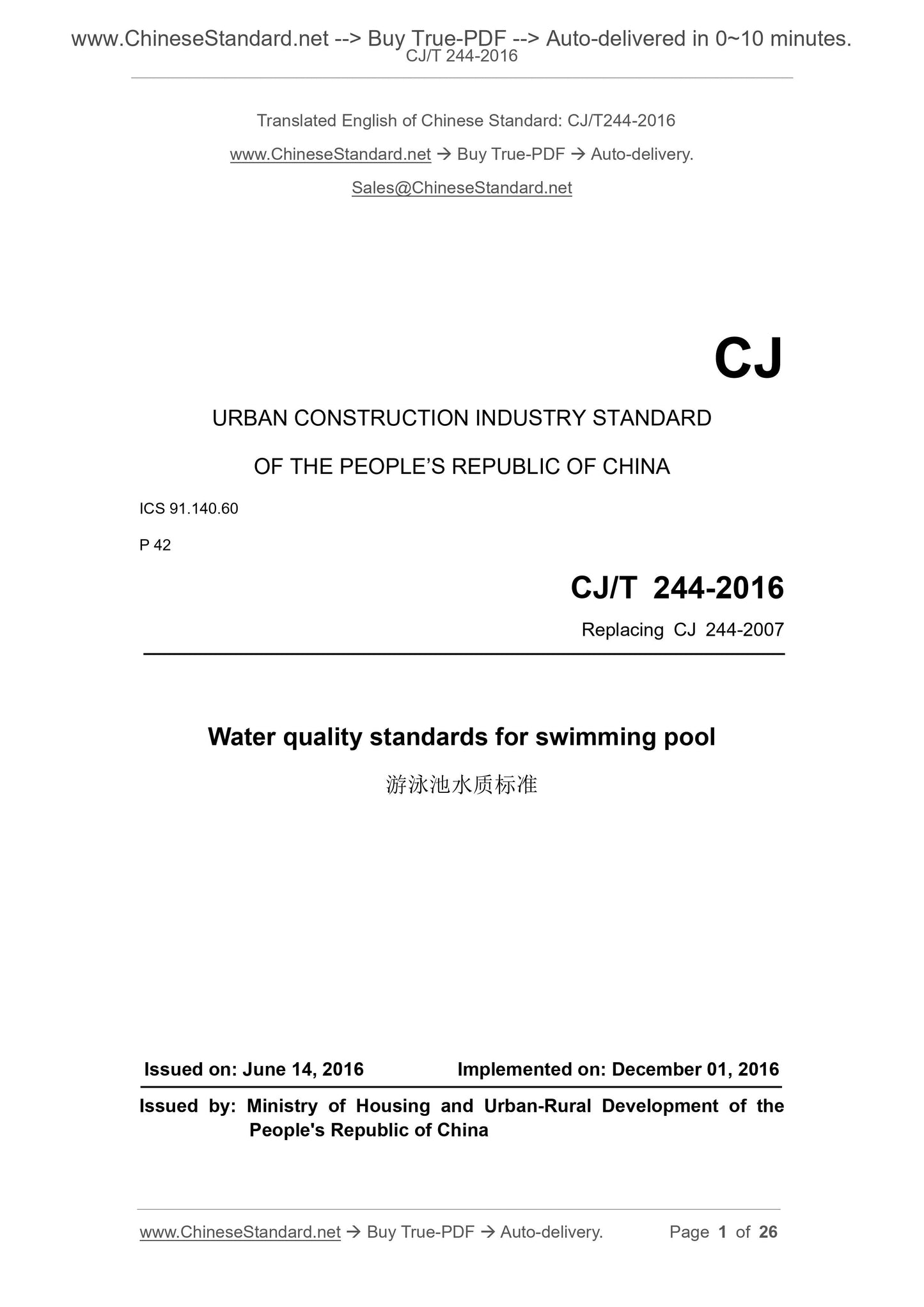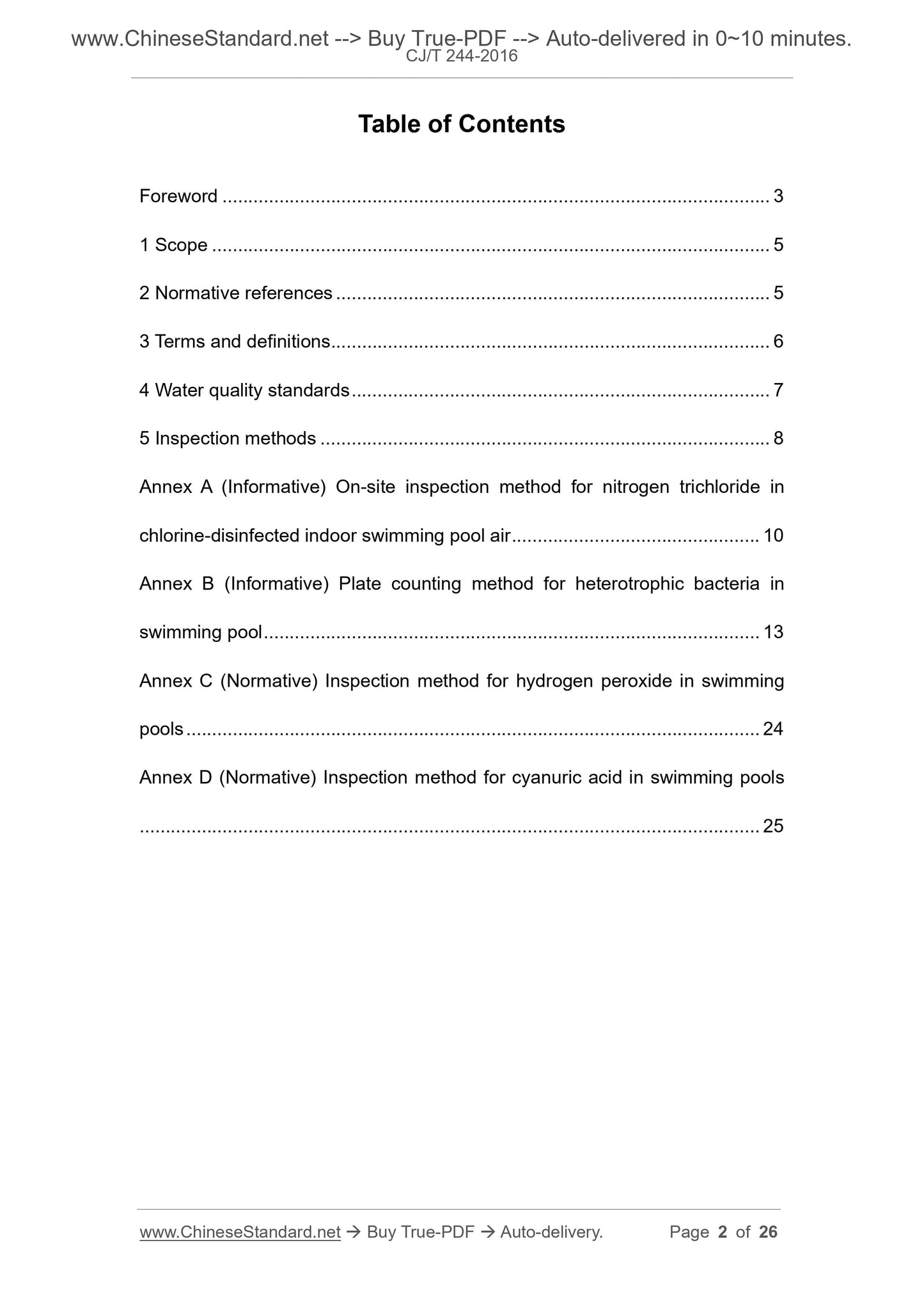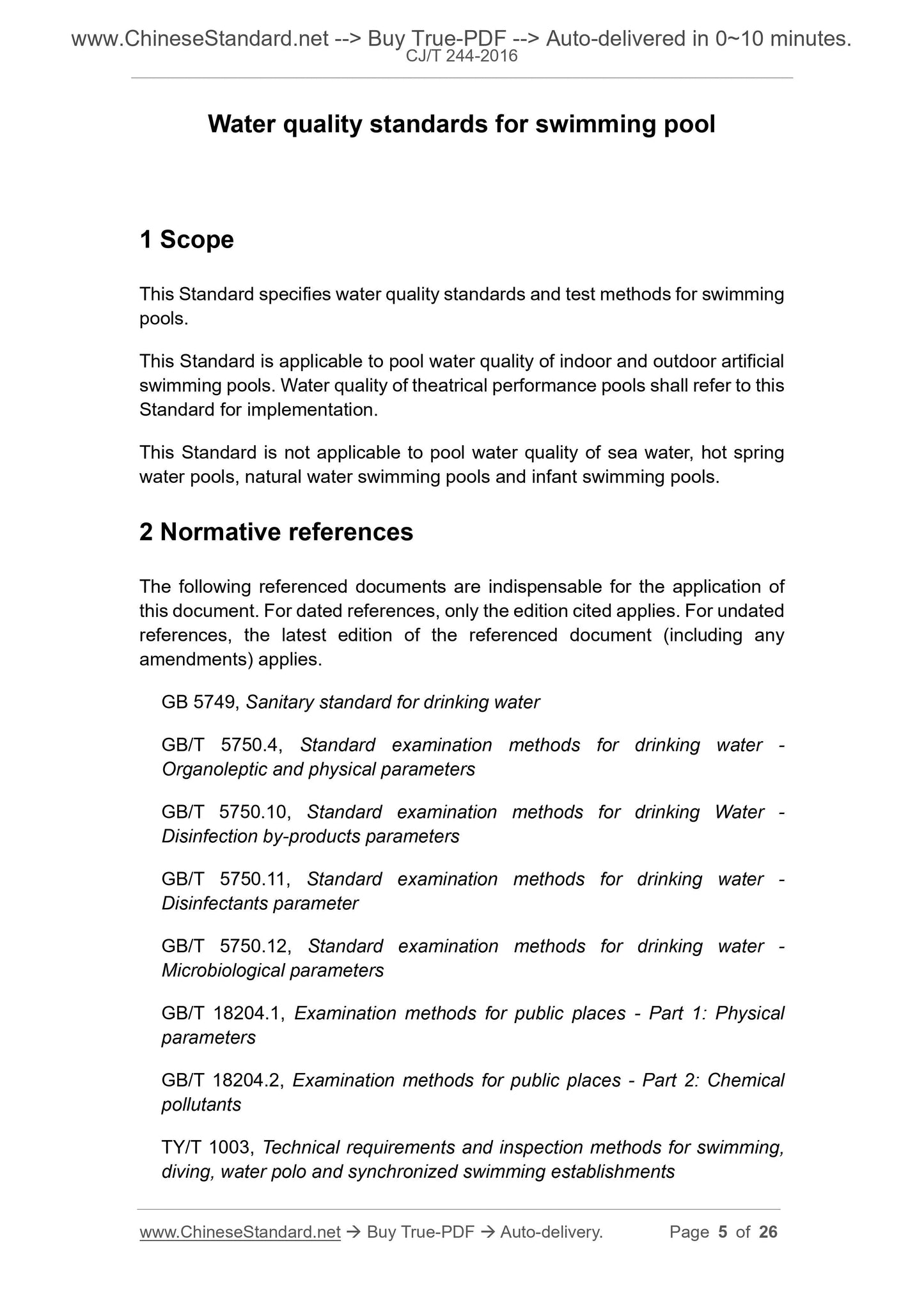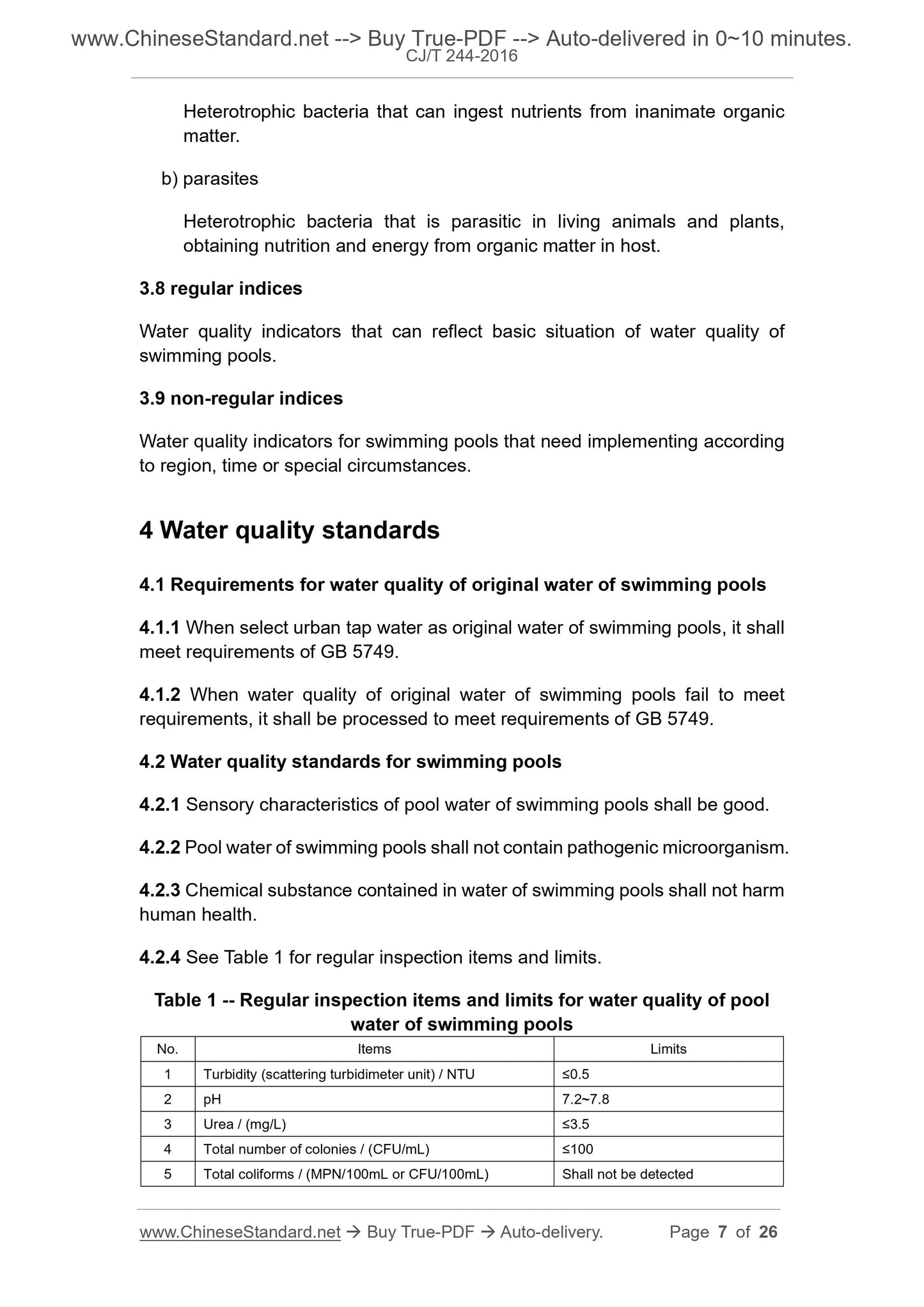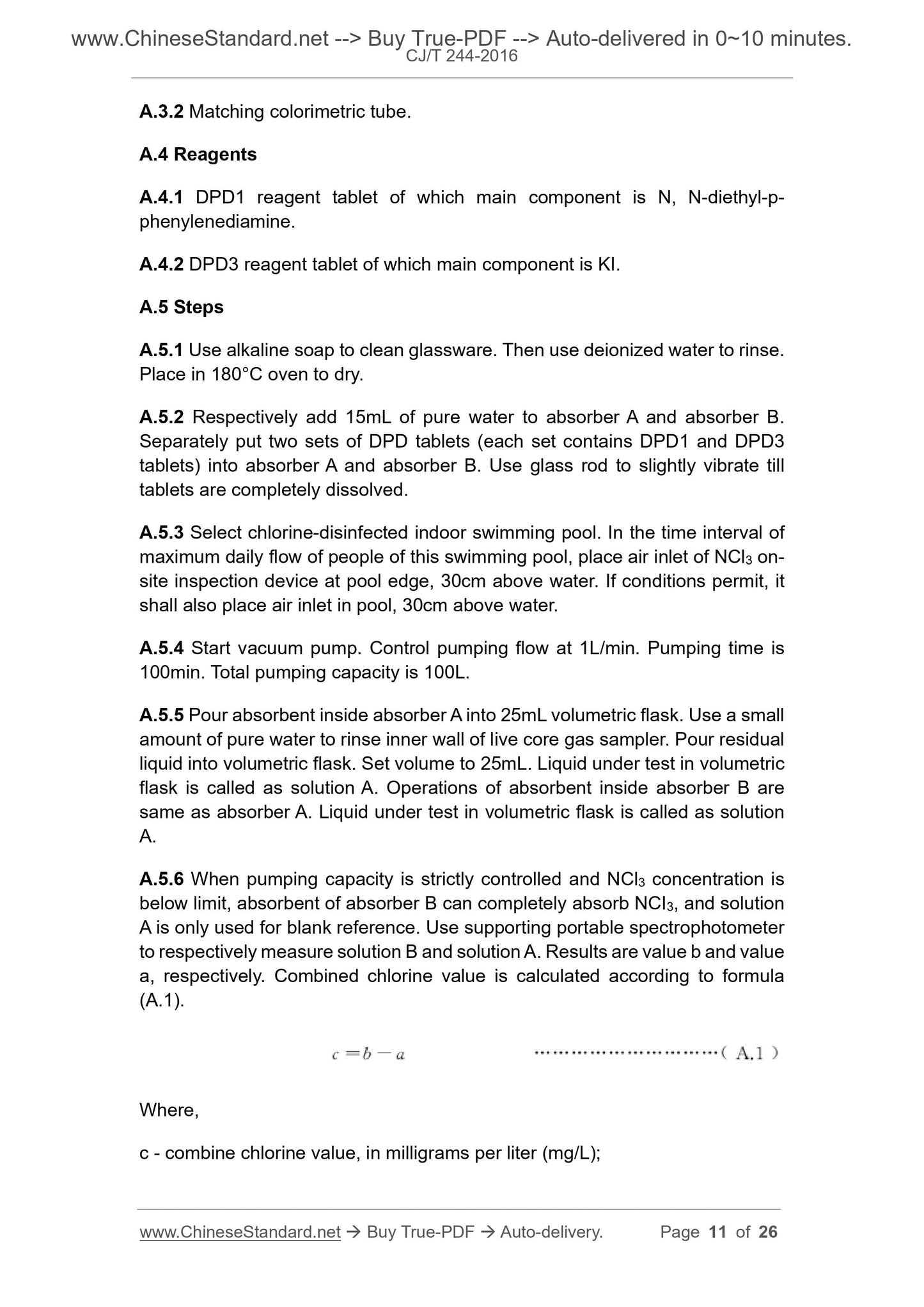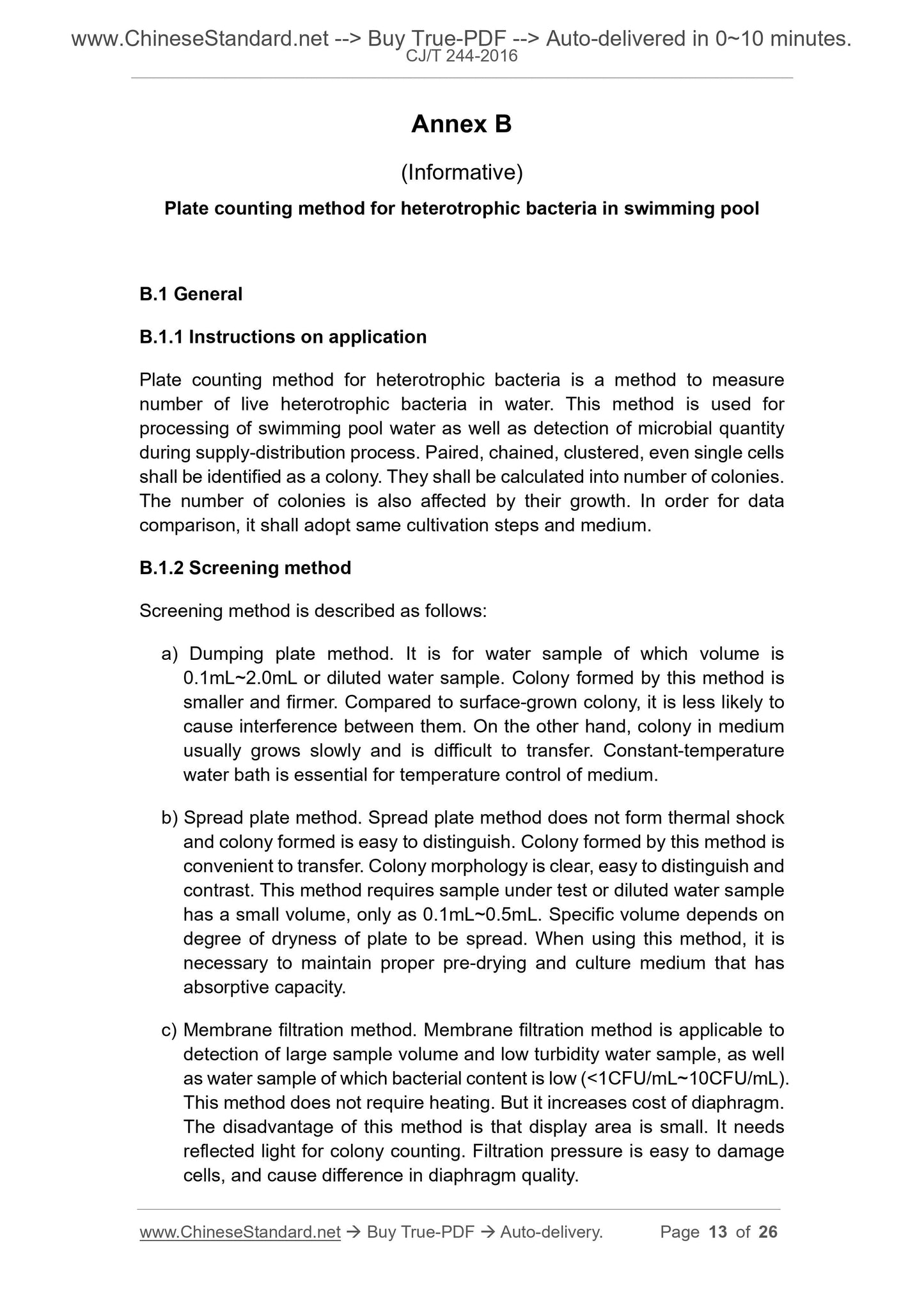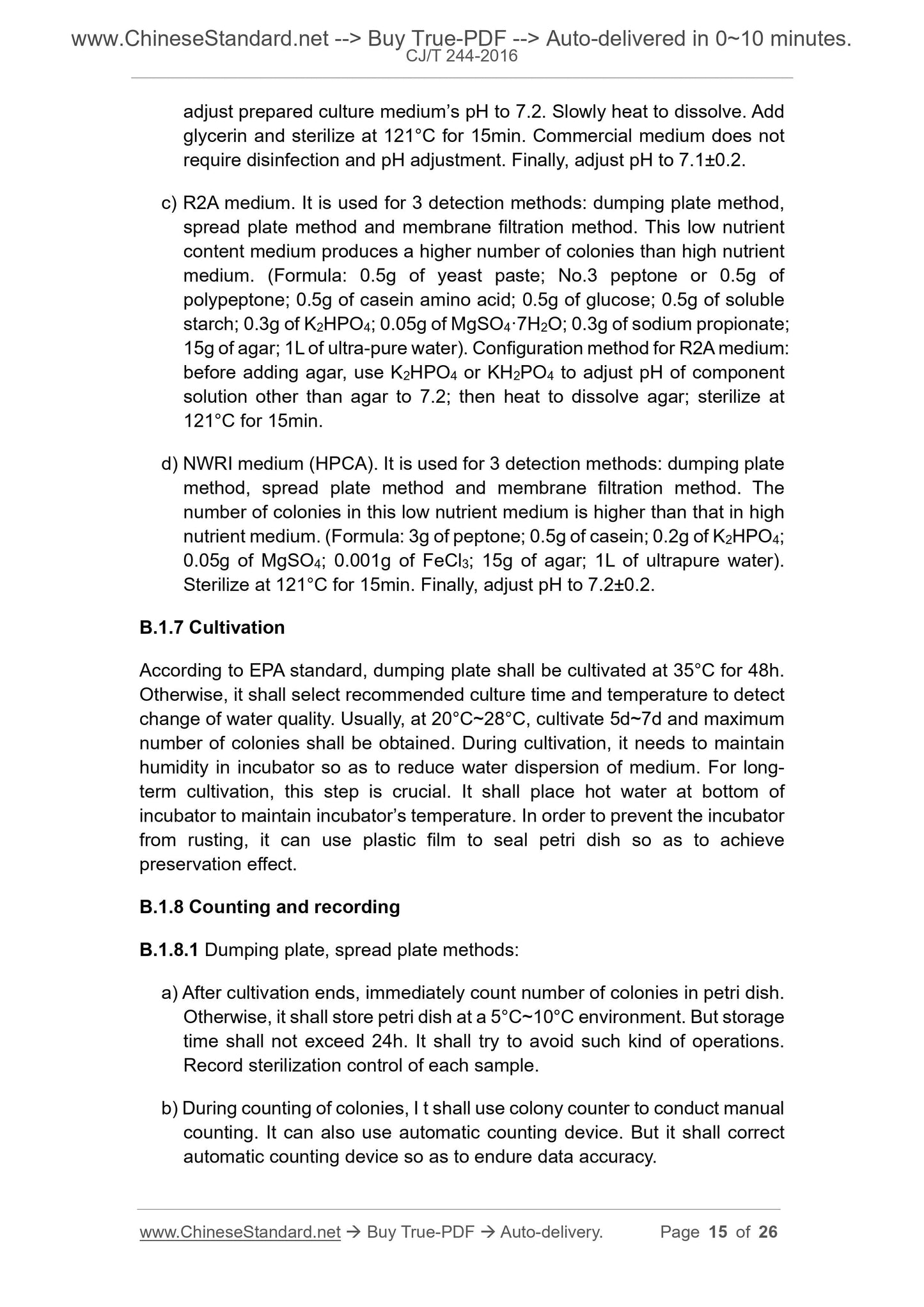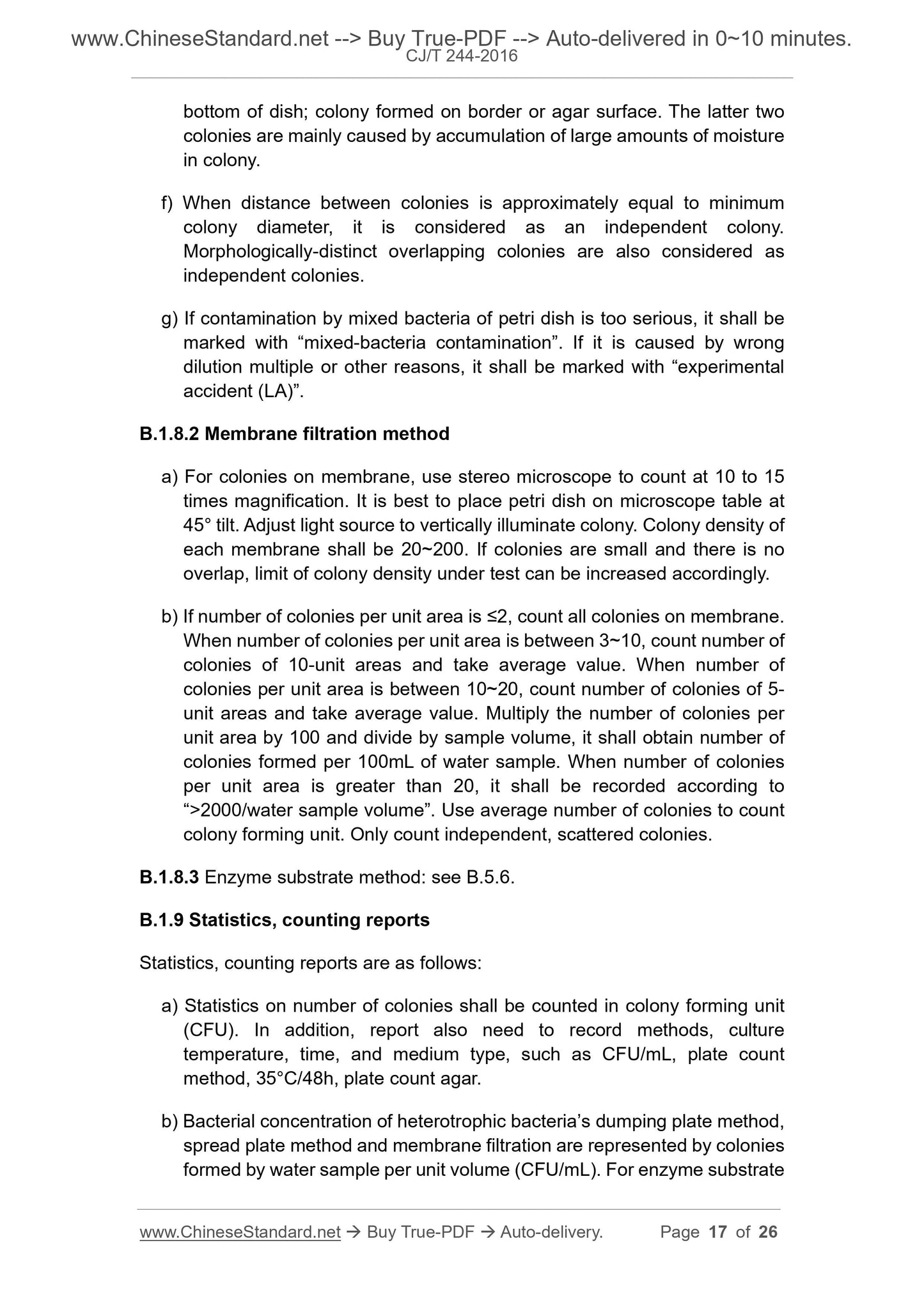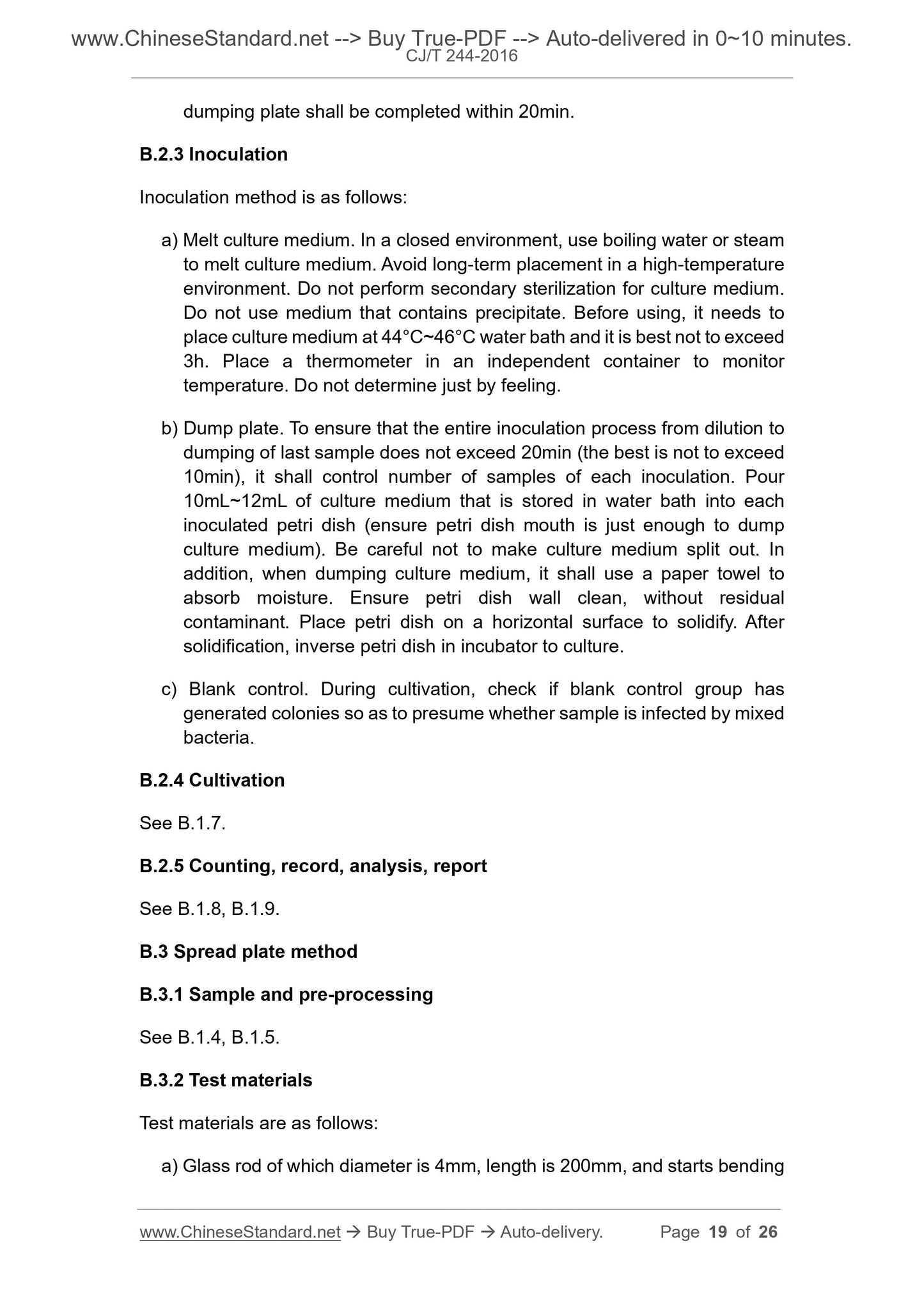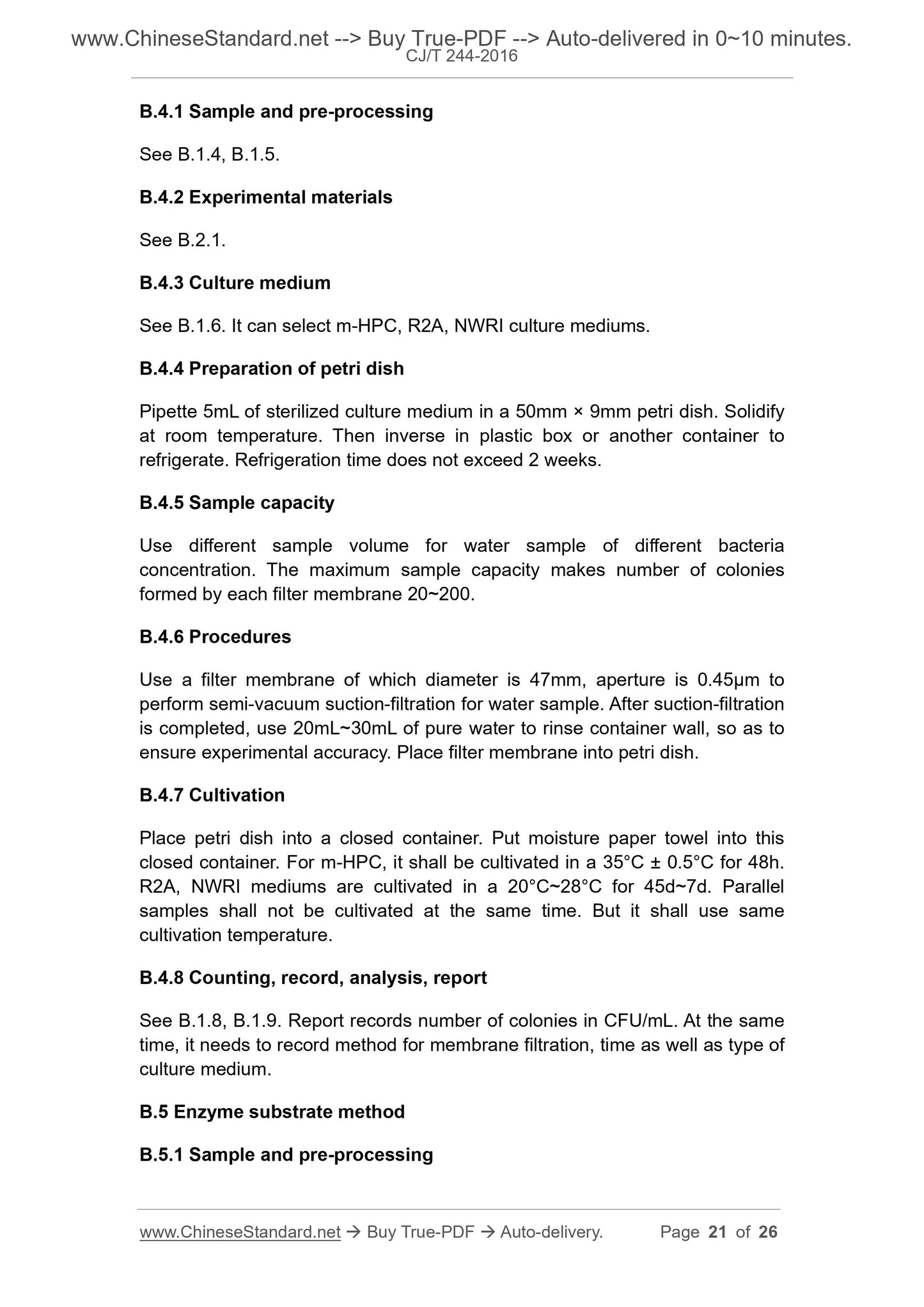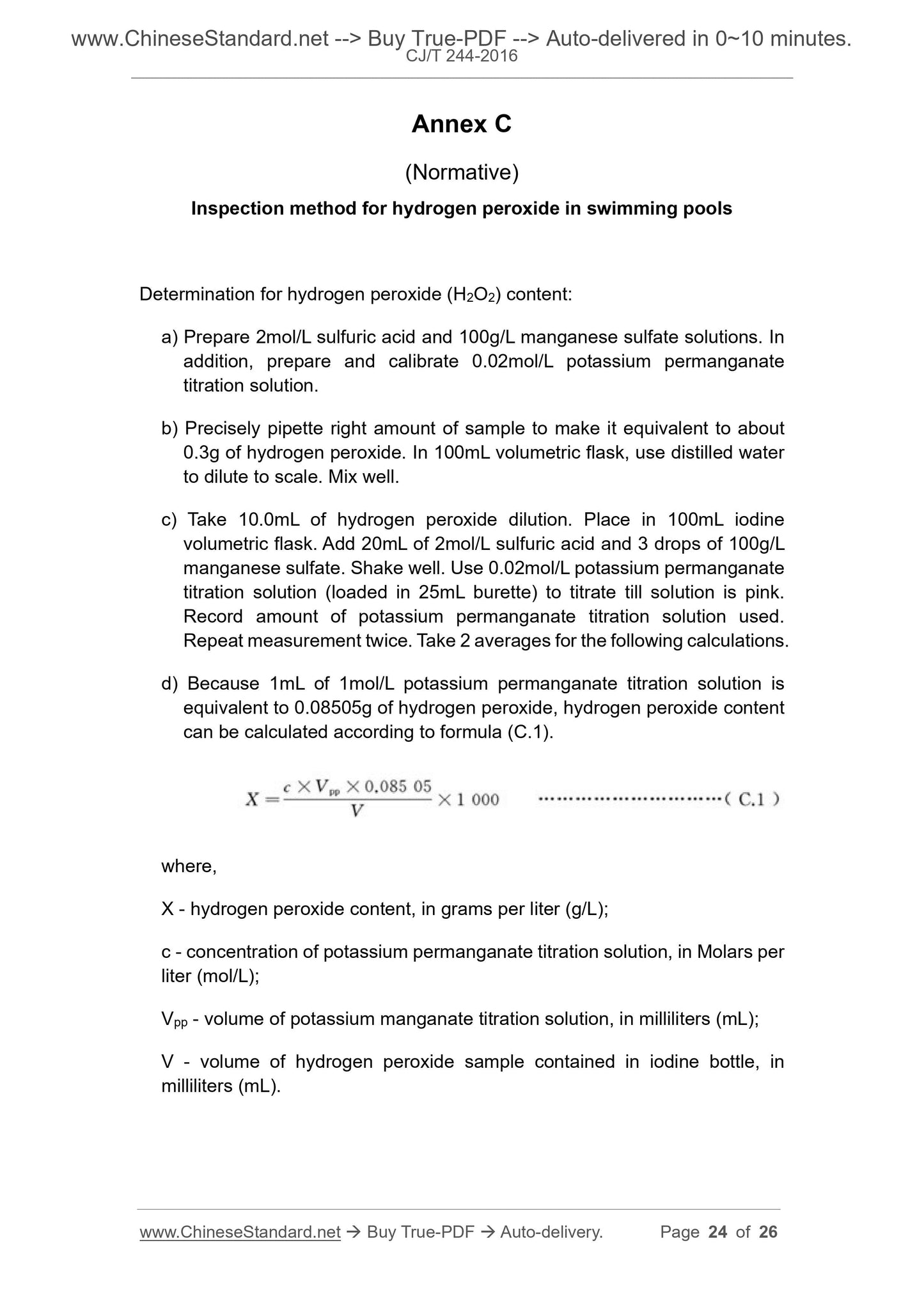PayPal, credit cards. Download editable-PDF and invoice in 1 second!
CJ/T 244-2016 English PDF (CJT244-2016)
CJ/T 244-2016 English PDF (CJT244-2016)
Precio habitual
$150.00 USD
Precio habitual
Precio de oferta
$150.00 USD
Precio unitario
/
por
Los gastos de envío se calculan en la pantalla de pago.
No se pudo cargar la disponibilidad de retiro
Delivery: 3 seconds. Download true-PDF + Invoice.
Get QUOTATION in 1-minute: Click CJ/T 244-2016
Historical versions: CJ/T 244-2016
Preview True-PDF (Reload/Scroll if blank)
CJ/T 244-2016: Water quality standards for swimming pool
CJ/T 244-2016
URBAN CONSTRUCTION INDUSTRY STANDARD
OF THE PEOPLE’S REPUBLIC OF CHINA
ICS 91.140.60
P 42
Replacing CJ 244-2007
Water quality standards for swimming pool
ISSUED ON: JUNE 14, 2016
IMPLEMENTED ON: DECEMBER 01, 2016
Issued by: Ministry of Housing and Urban-Rural Development of the
People's Republic of China
Table of Contents
Foreword ... 3
1 Scope ... 5
2 Normative references ... 5
3 Terms and definitions ... 6
4 Water quality standards ... 7
5 Inspection methods ... 8
Annex A (Informative) On-site inspection method for nitrogen trichloride in
chlorine-disinfected indoor swimming pool air ... 10
Annex B (Informative) Plate counting method for heterotrophic bacteria in
swimming pool ... 13
Annex C (Normative) Inspection method for hydrogen peroxide in swimming
pools ... 24
Annex D (Normative) Inspection method for cyanuric acid in swimming pools
... 25
Water quality standards for swimming pool
1 Scope
This Standard specifies water quality standards and test methods for swimming
pools.
This Standard is applicable to pool water quality of indoor and outdoor artificial
swimming pools. Water quality of theatrical performance pools shall refer to this
Standard for implementation.
This Standard is not applicable to pool water quality of sea water, hot spring
water pools, natural water swimming pools and infant swimming pools.
2 Normative references
The following referenced documents are indispensable for the application of
this document. For dated references, only the edition cited applies. For undated
references, the latest edition of the referenced document (including any
amendments) applies.
GB 5749, Sanitary standard for drinking water
GB/T 5750.4, Standard examination methods for drinking water -
Organoleptic and physical parameters
GB/T 5750.10, Standard examination methods for drinking Water -
Disinfection by-products parameters
GB/T 5750.11, Standard examination methods for drinking water -
Disinfectants parameter
GB/T 5750.12, Standard examination methods for drinking water -
Microbiological parameters
GB/T 18204.1, Examination methods for public places - Part 1: Physical
parameters
GB/T 18204.2, Examination methods for public places - Part 2: Chemical
pollutants
TY/T 1003, Technical requirements and inspection methods for swimming,
diving, water polo and synchronized swimming establishments
Heterotrophic bacteria that can ingest nutrients from inanimate organic
matter.
b) parasites
Heterotrophic bacteria that is parasitic in living animals and plants,
obtaining nutrition and energy from organic matter in host.
3.8 regular indices
Water quality indicators that can reflect basic situation of water quality of
swimming pools.
3.9 non-regular indices
Water quality indicators for swimming pools that need implementing according
to region, time or special circumstances.
4 Water quality standards
4.1 Requirements for water quality of original water of swimming pools
4.1.1 When select urban tap water as original water of swimming pools, it shall
meet requirements of GB 5749.
4.1.2 When water quality of original water of swimming pools fail to meet
requirements, it shall be processed to meet requirements of GB 5749.
4.2 Water quality standards for swimming pools
4.2.1 Sensory characteristics of pool water of swimming pools shall be good.
4.2.2 Pool water of swimming pools shall not contain pathogenic microorganism.
4.2.3 Chemical substance contained in water of swimming pools shall not harm
human health.
4.2.4 See Table 1 for regular inspection items and limits.
Table 1 -- Regular inspection items and limits for water quality of pool
water of swimming pools
No. Items Limits
1 Turbidity (scattering turbidimeter unit) / NTU ≤0.5
2 pH 7.2~7.8
3 Urea / (mg/L) ≤3.5
4 Total number of colonies / (CFU/mL) ≤100
5 Total coliforms / (MPN/100mL or CFU/100mL) Shall not be detected
A.3.2 Matching colorimetric tube.
A.4 Reagents
A.4.1 DPD1 reagent tablet of which main component is N, N-diethyl-p-
phenylenediamine.
A.4.2 DPD3 reagent tablet of which main component is KI.
A.5 Steps
A.5.1 Use alkaline soap to clean glassware. Then use deionized water to rinse.
Place in 180°C oven to dry.
A.5.2 Respectively add 15mL of pure water to absorber A and absorber B.
Separately put two sets of DPD tablets (each set contains DPD1 and DPD3
tablets) into absorber A and absorber B. Use glass rod to slightly vibrate till
tablets are completely dissolved.
A.5.3 Select chlorine-disinfected indoor swimming pool. In the time interval of
maximum daily flow of people of this swimming pool, place air inlet of NCl3 on-
site inspection device at pool edge, 30cm above water. If conditions permit, it
shall also place air inlet in pool, 30cm above water.
A.5.4 Start vacuum pump. Control pumping flow at 1L/min. Pumping time is
100min. Total pumping capacity is 100L.
A.5.5 Pour absorbent inside absorber A into 25mL volumetric flask. Use a small
amount of pure water to rinse inner wall of live core gas sampler. Pour residual
liquid into volumetric flask. Set volume to 25mL. Liquid under test in volumetric
flask is called as solution A. Operations of absorbent inside absorber B are
same as absorber A. Liquid under test in volumetric flask is called as solution
A.
A.5.6 When pumping capacity is strictly controlled and NCl3 concentration is
below limit, absorbent of absorber B can completely absorb NCI3, and solution
A is only used for blank reference. Use supporting portable spectrophotometer
to respectively measure solution B and solution A. Results are value b and value
a, respectively. Combined chlorine value is calculated according to formula
(A.1).
Where,
c - combine chlorine value, in milligrams per liter (mg/L);
Annex B
(Informative)
Plate counting method for heterotrophic bacteria in swimming pool
B.1 General
B.1.1 Instructions on application
Plate counting method for heterotrophic bacteria is a method to measure
number of live heterotrophic bacteria in water. This method is used for
processing of swimming pool water as well as detection of microbial quantity
during supply-distribution process. Paired, chained, clustered, even single cells
shall be identified as a colony. They shall be calculated into number of colonies.
The number of colonies is also affected by their growth. In order for data
comparison, it shall adopt same cultivation steps and medium.
B.1.2 Screening method
Screening method is described as follows:
a) Dumping plate method. It is for water sample of which volume is
0.1mL~2.0mL or diluted water sample. Colony formed by this method is
smaller and firmer. Compared to surface-grown colony, it is less likely to
cause interference between them. On the other hand, colony in medium
usually grows slowly and is difficult to transfer. Constant-temperature
water bath is essential for temperature control of medium.
b) Spread plate method. Spread plate method does not form thermal shock
and colony formed is easy to distinguish. Colony formed by this method is
convenient to transfer. Colony morphology is clear, easy to distinguish and
contrast. This method requires sample under test or diluted water sample
has a small volume, only as 0.1mL~0.5mL. Specific volume depends on
degree of dryness of plate to be spread. When using this method, it is
necessary to maintain ...
Get QUOTATION in 1-minute: Click CJ/T 244-2016
Historical versions: CJ/T 244-2016
Preview True-PDF (Reload/Scroll if blank)
CJ/T 244-2016: Water quality standards for swimming pool
CJ/T 244-2016
URBAN CONSTRUCTION INDUSTRY STANDARD
OF THE PEOPLE’S REPUBLIC OF CHINA
ICS 91.140.60
P 42
Replacing CJ 244-2007
Water quality standards for swimming pool
ISSUED ON: JUNE 14, 2016
IMPLEMENTED ON: DECEMBER 01, 2016
Issued by: Ministry of Housing and Urban-Rural Development of the
People's Republic of China
Table of Contents
Foreword ... 3
1 Scope ... 5
2 Normative references ... 5
3 Terms and definitions ... 6
4 Water quality standards ... 7
5 Inspection methods ... 8
Annex A (Informative) On-site inspection method for nitrogen trichloride in
chlorine-disinfected indoor swimming pool air ... 10
Annex B (Informative) Plate counting method for heterotrophic bacteria in
swimming pool ... 13
Annex C (Normative) Inspection method for hydrogen peroxide in swimming
pools ... 24
Annex D (Normative) Inspection method for cyanuric acid in swimming pools
... 25
Water quality standards for swimming pool
1 Scope
This Standard specifies water quality standards and test methods for swimming
pools.
This Standard is applicable to pool water quality of indoor and outdoor artificial
swimming pools. Water quality of theatrical performance pools shall refer to this
Standard for implementation.
This Standard is not applicable to pool water quality of sea water, hot spring
water pools, natural water swimming pools and infant swimming pools.
2 Normative references
The following referenced documents are indispensable for the application of
this document. For dated references, only the edition cited applies. For undated
references, the latest edition of the referenced document (including any
amendments) applies.
GB 5749, Sanitary standard for drinking water
GB/T 5750.4, Standard examination methods for drinking water -
Organoleptic and physical parameters
GB/T 5750.10, Standard examination methods for drinking Water -
Disinfection by-products parameters
GB/T 5750.11, Standard examination methods for drinking water -
Disinfectants parameter
GB/T 5750.12, Standard examination methods for drinking water -
Microbiological parameters
GB/T 18204.1, Examination methods for public places - Part 1: Physical
parameters
GB/T 18204.2, Examination methods for public places - Part 2: Chemical
pollutants
TY/T 1003, Technical requirements and inspection methods for swimming,
diving, water polo and synchronized swimming establishments
Heterotrophic bacteria that can ingest nutrients from inanimate organic
matter.
b) parasites
Heterotrophic bacteria that is parasitic in living animals and plants,
obtaining nutrition and energy from organic matter in host.
3.8 regular indices
Water quality indicators that can reflect basic situation of water quality of
swimming pools.
3.9 non-regular indices
Water quality indicators for swimming pools that need implementing according
to region, time or special circumstances.
4 Water quality standards
4.1 Requirements for water quality of original water of swimming pools
4.1.1 When select urban tap water as original water of swimming pools, it shall
meet requirements of GB 5749.
4.1.2 When water quality of original water of swimming pools fail to meet
requirements, it shall be processed to meet requirements of GB 5749.
4.2 Water quality standards for swimming pools
4.2.1 Sensory characteristics of pool water of swimming pools shall be good.
4.2.2 Pool water of swimming pools shall not contain pathogenic microorganism.
4.2.3 Chemical substance contained in water of swimming pools shall not harm
human health.
4.2.4 See Table 1 for regular inspection items and limits.
Table 1 -- Regular inspection items and limits for water quality of pool
water of swimming pools
No. Items Limits
1 Turbidity (scattering turbidimeter unit) / NTU ≤0.5
2 pH 7.2~7.8
3 Urea / (mg/L) ≤3.5
4 Total number of colonies / (CFU/mL) ≤100
5 Total coliforms / (MPN/100mL or CFU/100mL) Shall not be detected
A.3.2 Matching colorimetric tube.
A.4 Reagents
A.4.1 DPD1 reagent tablet of which main component is N, N-diethyl-p-
phenylenediamine.
A.4.2 DPD3 reagent tablet of which main component is KI.
A.5 Steps
A.5.1 Use alkaline soap to clean glassware. Then use deionized water to rinse.
Place in 180°C oven to dry.
A.5.2 Respectively add 15mL of pure water to absorber A and absorber B.
Separately put two sets of DPD tablets (each set contains DPD1 and DPD3
tablets) into absorber A and absorber B. Use glass rod to slightly vibrate till
tablets are completely dissolved.
A.5.3 Select chlorine-disinfected indoor swimming pool. In the time interval of
maximum daily flow of people of this swimming pool, place air inlet of NCl3 on-
site inspection device at pool edge, 30cm above water. If conditions permit, it
shall also place air inlet in pool, 30cm above water.
A.5.4 Start vacuum pump. Control pumping flow at 1L/min. Pumping time is
100min. Total pumping capacity is 100L.
A.5.5 Pour absorbent inside absorber A into 25mL volumetric flask. Use a small
amount of pure water to rinse inner wall of live core gas sampler. Pour residual
liquid into volumetric flask. Set volume to 25mL. Liquid under test in volumetric
flask is called as solution A. Operations of absorbent inside absorber B are
same as absorber A. Liquid under test in volumetric flask is called as solution
A.
A.5.6 When pumping capacity is strictly controlled and NCl3 concentration is
below limit, absorbent of absorber B can completely absorb NCI3, and solution
A is only used for blank reference. Use supporting portable spectrophotometer
to respectively measure solution B and solution A. Results are value b and value
a, respectively. Combined chlorine value is calculated according to formula
(A.1).
Where,
c - combine chlorine value, in milligrams per liter (mg/L);
Annex B
(Informative)
Plate counting method for heterotrophic bacteria in swimming pool
B.1 General
B.1.1 Instructions on application
Plate counting method for heterotrophic bacteria is a method to measure
number of live heterotrophic bacteria in water. This method is used for
processing of swimming pool water as well as detection of microbial quantity
during supply-distribution process. Paired, chained, clustered, even single cells
shall be identified as a colony. They shall be calculated into number of colonies.
The number of colonies is also affected by their growth. In order for data
comparison, it shall adopt same cultivation steps and medium.
B.1.2 Screening method
Screening method is described as follows:
a) Dumping plate method. It is for water sample of which volume is
0.1mL~2.0mL or diluted water sample. Colony formed by this method is
smaller and firmer. Compared to surface-grown colony, it is less likely to
cause interference between them. On the other hand, colony in medium
usually grows slowly and is difficult to transfer. Constant-temperature
water bath is essential for temperature control of medium.
b) Spread plate method. Spread plate method does not form thermal shock
and colony formed is easy to distinguish. Colony formed by this method is
convenient to transfer. Colony morphology is clear, easy to distinguish and
contrast. This method requires sample under test or diluted water sample
has a small volume, only as 0.1mL~0.5mL. Specific volume depends on
degree of dryness of plate to be spread. When using this method, it is
necessary to maintain ...
Share
